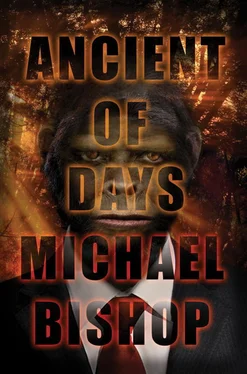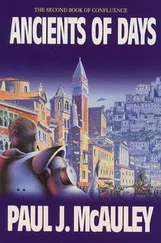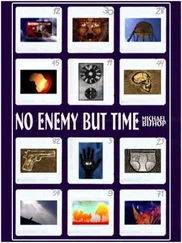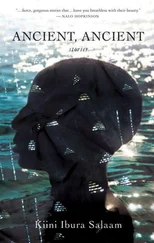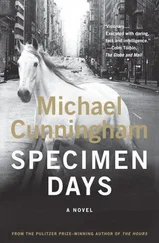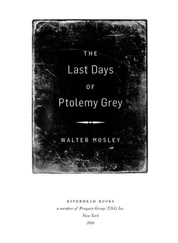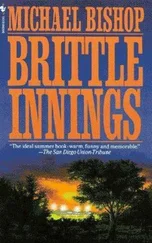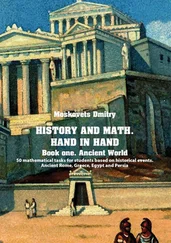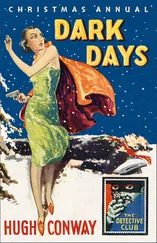“That’s what Adam was doing last night,” I said. “What Adam and Erzulie were doing, I mean. With the snake.”
“Exactly,” RuthClaire said. “Getting in touch with their habiline past. And a trip through these caves can do the same in a way that brings all the rite’s participants closer together. The first cave painters probably began their work believing it would help their people survive by educating and unifying them. It would give them a sense of the sacred. Sadly, the twentieth century has been pretty efficient at destroying the sacred. And how could the cave painters know that a man named Papa Doc would turn into their Stalin, their Hitler, their Pol Pot? They’d never heard of any of these butchers.”
“Voodoo and revelation,” Brian said. “What did you mean by revelation?”
Adam’s lamp lit him from beneath, giving him the look of a disembodied floating head. “That God revealed himself to early Homo habilis as he later revealed himself to the Hebrews. Even as we approach extinction, we know we were favored by the earliest manifestation of God to a hominid species yet on record—even if it is on record only with us. We know we have our own Christ.”
“Your own Christ?”
“Not a prehistoric Jesus of Nazareth,” Adam told Brian. “But God in a form of flesh that any habiline would regard as holy: our own Christ.”
Somehow, our sensoriums overloaded with data, we groped our way to the surface and then back down the mountain to Prix-des-Yeux. Hector remained behind in the pitch-black darkness of the caves. He, after all, was their curator.
In the village, Adam took Caroline and me into the hut that Alberoi was sharing with Erzulie. Its interior was larger than its haphazard outer walls and carpentering had led me to think possible. Alberoi knelt toward the rear of the shanty beneath a hole in the roof through which fell a dusty column of sunlight. Was he sick? I thought for a moment that a stomach cramp had taken him, that he had assumed this hangdog posture to vomit—but then I realized that he was hovering over a small sheet of canvas tacked to a piece of plywood lying flat on the floor. With the edge of a rusted spoon, he applied paint to the canvas: the artist in his studio. Indeed, the hole in the roof served him as a skylight. A rain-warped hatch cover rested on one end of this opening, waiting for the hut’s occupant to grab its handle and slide it into place. In the event of rain, that act would offer a bit of protection. Mostly, though, it would plunge the hut’s interior into leaky gloom.
Speaking hesitant but well-accented French, Adam told Alberoi that we’d come to see his and the others’ paintings. The habiline backed off his canvas and squatted with his spine to the wall and his eyes cutting between RuthClaire and me. He still had his spoon. The pigment on it was a crimson acrylic, as if he had been sneaking tastes from a forbidden bowl of strawberry Jell-O: a naughty boy caught red-handed. We stepped around the room’s clutter—including a large crate resting on a foundation of bricks, a strip of oilcloth covering it—to see what Alberoi had been painting. Fortunately, he was fairly far along in the work, and I could tell a good deal about his talent.
He had talent. The painting was a colorful market scene in the “naive” style that had dominated David Blau’s Haitian exhibit at Abraxas: accessible, representational art. Its human figures had an affinity with the human-habiline figures on the walls of Hector’s caves, but its setting was modern. I recognized the market as the market in Rutherford’s Port. Vegetable stalls, milling people in bright clothes, a pair of buses with baskets tied to their roofs, groups of native musicians soliciting money from tourists. What drew my eye faster than these elements, however, was the grinning, dawdling giraffe in the midst of the crowd, none of whose members regarded its presence as a cause for either alarm or celebration. The giraffe belonged to the scene as surely as did the buses or the women in market garb. Delighted, Adam actually laughed aloud.
“Very good, Alberoi. Excellent.”
“A giraffe?” Caroline said.
“He knows my secret,” Adam said, as if that explained anything. “Do you think you could sell a painting like this, Mister Paul?”
“Sure. With no trouble at all.”
“Then come see the others.” He led me to the crate up on bricks—like a teenager’s engineless jalopy, I thought—and when we were out of his way, Alberoi crept back to his painting, laid the spoon aside, and took up a fine-tipped brush from a tray of acrylics. With this brush, he stippled in the mountain shrubbery behind the market. His concentration was intense. The rest of us might as well have been in Miami Beach.
Adam lifted the oilcloth covering the crate, which thin plywood dividers sectioned into a dozen compartments. Its cover off, the crate looked like a makeshift filing cabinet. Each compartment held canvases, some rolled, some stretched taut on narrow frames. We pulled the paintings from the crate and examined them. Almost all were in the bright naive style of the market scene that Alberoi was finishing. Several were portraits—or self-portraits—of Prix-des-Yeux people, the best being those of Erzulie and Dégrasse, as if the artists preferred the female countenance to the male. Three or four of the paintings, in stark contrast to the majority, radiated a gray or muddy-blue pessimism rather than a gaudy Caribbean joy, but their subjects were Tontons Macoutes or demons from local voodoo lore. Flipping past these, I saw several moderately realistic renderings of such loa as Damballa, Petro Simbi, and Ogou Achade, who is famous for being able to drink a great deal without becoming drunk. Unlike the demons, the loa were presented positively—in citrus-fruit colors and broad but enigmatic smiles. I liked what I saw.
“Am I supposed to photograph these?” I asked Adam.
“Only if you wish. Take a few with you, if you like, champion them about, and sell them for modest prices. Keep your commission and send the rest to RuthClaire and me. We can ship others to you, if your markets will bear such an influx.”
“I’ll take ten or twelve,” I said. “It’s probably best to see what sorts of interest they’ll generate before taking the lot.”
“You don’t want all of them?” Caroline asked me. “You’ll sell every habiline painting, or toenail clipping, entrusted to you.”
“But he won’t let me identify them as habiline artifacts.”
Caroline looked at Adam. “No? That’s self-defeating.”
“I am not trying to mop up, Miss Caroline, only to preserve what’s preservable and to pay for the privilege as we go.”
I had noticed an unusual, although perhaps not surprising, fact about all the paintings in the crate. “Adam, not one of these is signed. What names do you want to give the artists? I need names for gallery owners and department-store buyers.”
“Not names , Mister Paul. One name.”
I glanced at Alberoi. “He didn’t do all of these, did he? Didn’t you say Erzulie painted too? And all the others, for that matter?”
“Erzulie does. Likewise the others. But only one name is necessary for all the paintings, don’t you think? Regard them closely.”
I did as Adam asked. Caroline helped me compare. The canvases, no matter their subjects, did seem the work of a single hand. Brush strokes, color choices, draftsmanship, compositional techniques, overlay patterns—all these telltale criteria suggested but one artist. Even the bleak portraits of the Tontons Macoutes and the Arada-Dahomey demons differed from the other paintings only in color choice, and it was hard to think of many artists who did not sometimes vary their palettes to imply the full spectrum of human feelings. (RuthClaire had stayed with murky pastels for the Souls series, of course, but that series composed only a small fraction of her total output.) So, yes, it would make some sense, and simplify my marketing approach, to offer these paintings to prospective buyers as the work of a solitary talented naif.
Читать дальше
